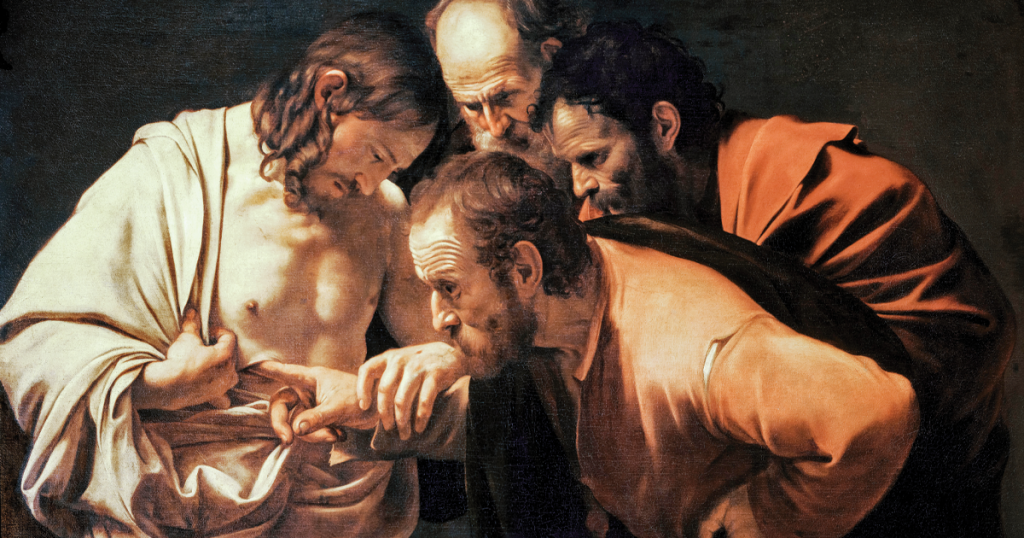My Scars & His
“As he spoke, he showed them his hands and feet” (Luke 24:40).
I had surgery this past year. During my pre-op session with the surgeon, my husband asked how extensive the scarring might be, to which the doctor replied that he’d do his best to keep them to a minimum. For several months afterwards, I prayed daily that the scars would fade, and to a certain extent, they have. But every time I dress, I still see them and I remember. After His resurrection, Jesus appeared to His disciples. They were frightened, initially believing that they were seeing a ghost. So, to prove the reality of what they were seeing, Jesus reached out and showed them the scars on His hands and feet. He encouraged the disciples to touch them. It was His body, still bearing the scars of the crucifixion, but now risen from death.
Despite this, however, I am relatively sure the disciples were still confused. I would have been. If I hadn’t read the passages in Luke and John about Christ’s scars, I too would assume that a glorified, resurrected body wouldn’t bear such defects. After all, scars are signs of imperfection, a defacement, something most of us try to hide.
Jesus gave sight to the blind, healed the sick, cast out demons and even raised the dead. Removing those scars would have been easy. He could have made His hands, feet and side perfect and whole again. But He chose not to. His Father could have removed the scars from His Son’s eternal glorified flesh too. But He also chose not to. Why? Why would Christ choose to bear a sign that recalls the painful wounds that were inflicted upon Him?
I believe He kept His scars not from an inability to heal them, but as a sign of the fact that He would do anything for us. Roman crucifixion was as gruesome and humiliating a death as could be imagined. The accused were beaten savagely with a whip, first tearing skin and then muscle. Ribs were often broken from the repeated blows. They would then be forced to pick up and carry the beam of the cross on which they would be hung. The condemned were stripped naked so as to die with as little dignity as possible, and iron spikes that averaged 5-7 inches in length were used to nail their wrists and feet to the cross. It was a slow and painful death.
I cannot imagine for one moment the suffering, the anguish and the loneliness that Jesus was feeling as He hung on that cross for my sins. His scars are a reminder to me of an extraordinary act of sacrificial love.
His scars are an everlasting trophy of His victory over death. A scar means that the hurt is over, the pain conquered and the wound closed. Healing is complete. In the same way, the ugliness of Good Friday opened the gates of Heaven to our healing from sin. 1 Peter 2:24 tells us, “He himself bore our sins in his body on the tree, that we might die to sin and live to righteousness.” By His wounds, we Christians have been fully healed and are reminded constantly that we also have victory over death.
And in a way, there is something beautiful and comforting in knowing that Jesus Christ shows off His scars. If Christ could find purpose in them, so must we. If Christ could exhibit His scars so shamelessly, so should we.
Jane visited her hairdresser for a haircut. She sat quietly in the chair as her hair fell to the ground. With each snip of the scissors, another question came her way: “Remind me what you do for work?” “Are you dating anyone?” “Did you want layers today?”
Jane stared at her reflection in the mirror as she answered each inquiry. She asked a few questions herself, and then holding her breath, she wondered if she’d be asked about the huge scar on the top of her head. At first the hairdresser didn’t say anything and continued as if it didn’t exist. But finally, the question emerged: “Tell me about your scar.” Delighted to tell her story, Jane explained that she had brain surgery. She described in detail why she called it “the miracle written on her skin.”
Every one of our scars, whether evident or not, tell a story. Indeed, some of the worst wounds hide in the unseen places of our hearts. Wounds from cruel words spoken or kind words withheld. Wounds from loss, divorce or addiction. Wounds from love betrayed and promises broken. The miracle is that when they are given to Christ, He heals our wounds and replaces them with scars. And he does this not to remind us that we have been hurt. On the contrary. He gives us scars to remind us that we have been healed, delivered and set free. They are proof that His love for us is more powerful than pain, death or destruction. And we must never forget that God does not just heal us for our own sake. There are people who need to see and touch those scars. They need to hear our stories of healing and restoration. They need to see evidence of God’s love and victory.
I no longer try to hide my scars. In fact, I like looking at them. Although I once thought of them as a weakness, an ugly flaw, I now see each one as a precious mark of my spiritual journey, a strength, a beautiful trophy of God’s faithfulness and love.
Clint Lagerberg and Nichole Nordeman penned these beautiful lyrics that have become my personal prayer:
Everything You’ve done for me
Don’t let me forget
The beauty in the suffering
Heal the wound but leave the scar
A reminder of how merciful You are
I am broken, torn apart, take the pieces of this heart
Heal the wound but leave the scar
May we never forget the words found in Isaiah 53:5: “He was hurt because of us; he suffered so. Our wrongdoing wounded and crushed him. He endured the breaking that made us whole. The injuries he suffered became our healing” (VOICE).
Commissioner Jolene K. Hodder is the National Secretary for Program at National Headquarters in Alexandria, VA.







